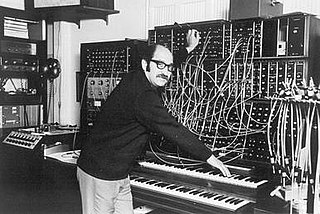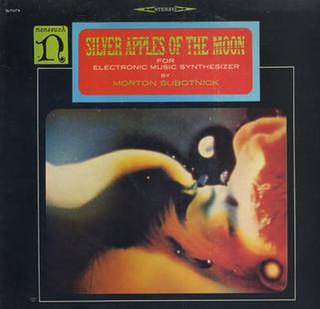Electronic music broadly is a group of music genres that employ electronic musical instruments, circuitry-based music technology and software, or general-purpose electronics in its creation. It includes both music made using electronic and electromechanical means. Pure electronic instruments depended entirely on circuitry-based sound generation, for instance using devices such as an electronic oscillator, theremin, or synthesizer. Electromechanical instruments can have mechanical parts such as strings, hammers, and electric elements including magnetic pickups, power amplifiers and loudspeakers. Such electromechanical devices include the telharmonium, Hammond organ, electric piano and electric guitar.
Wendy Carlos is an American musician and composer best known for her electronic music and film scores.

Digital music technology encompasses digital instruments, computers, electronic effects units, software, or digital audio equipment by a performer, composer, sound engineer, DJ, or record producer to produce, perform or record music. The term refers to electronic devices, instruments, computer hardware, and software used in performance, playback, recording, composition, mixing, analysis, and editing of music.

Isao Tomita, often known simply as Tomita, was a Japanese composer, regarded as one of the pioneers of electronic music and space music, and as one of the most famous producers of analog synthesizer arrangements. In addition to creating note-by-note realizations, Tomita made extensive use of the sound-design capabilities of his instrument, using synthesizers to create new sounds to accompany and enhance his electronic realizations of acoustic instruments. He also made effective use of analog music sequencers and the Mellotron, and featured futuristic science-fiction themes, while laying the foundations for synth-pop music and trance-like rhythms. Many of his albums are electronic versions and adaptations of familiar classical music pieces. He received four Grammy Award nominations for his 1974 album based on music by Claude Debussy, Snowflakes Are Dancing.
A soundscape is the acoustic environment as perceived by humans, in context. The term was originally coined by Michael Southworth, and popularised by R. Murray Schafer. There is a varied history of the use of soundscape depending on discipline, ranging from urban design to wildlife ecology to computer science. An important distinction is to separate soundscape from the broader acoustic environment. The acoustic environment is the combination of all the acoustic resources, natural and artificial, within a given area as modified by the environment. The International Organization for Standardization (ISO) standardized these definitions in 2014.

Nonesuch Records is an American record company and label owned by Warner Music Group, distributed by Warner Records, and based in New York City. Founded by Jac Holzman in 1964 as a budget classical label, Nonesuch has developed into a label that records critically acclaimed music from a wide range of genres. Robert Hurwitz was president of the company from 1984 to 2017.

Morton Sanford Garson was a Canadian composer, arranger, songwriter, and pioneer of electronic music. He is best known for his albums in the 1960s and 1970s, such as Mother Earth's Plantasia (1976). He also co-wrote several hit songs, including "Our Day Will Come", a hit for Ruby & the Romantics. According to Allmusic, "Mort Garson boasts one of the most unique and outright bizarre resumés in popular music, spanning from easy listening to occult-influenced space-age electronic pop."
Paul Henry Beaver Jr. was an American musician who was a pioneer in popular electronic music, using the Moog synthesizer. From 1967, Beaver collaborated with Bernie Krause as the recording duo Beaver & Krause.

Electronic Sound is the second studio album by English rock musician George Harrison. Released in May 1969, it was the last of two LPs issued on the Beatles' short-lived Zapple record label, a subsidiary of Apple Records that specialised in the avant-garde. The album is an experimental work comprising two lengthy pieces performed on a Moog 3-series synthesizer. It was one of the first electronic music albums by a rock musician, made at a time when the Moog was usually played by dedicated exponents of the technology. Harrison subsequently introduced the Moog to the Beatles' sound, and the band featured synthesizer for the first time on their 1969 album Abbey Road.
Natural sounds are any sounds produced by non-human organisms as well as those generated by natural, non-biological sources within their normal soundscapes. It is a category whose definition is open for discussion. Natural sounds create an acoustic space.
Beaver & Krause were an American musical duo comprising Paul Beaver and Bernie Krause. Their 1967 album The Nonesuch Guide to Electronic Music was a pioneering work in the electronic music genre. The pair were Robert Moog's sales representatives on the U.S. West Coast and were instrumental in popularizing the Moog synthesizer during the late 1960s. As recording artists for Warner Bros. Records in the early 1970s, they released the critically admired albums In a Wild Sanctuary and Gandharva.
Acoustic ecology, sometimes called ecoacoustics or soundscape studies, is a discipline studying the relationship, mediated through sound, between human beings and their environment. Acoustic ecology studies started in the late 1960s with R. Murray Schafer a musician, composer and former professor of communication studies at Simon Fraser University with the help of his team there as part of the World Soundscape Project. The original WSP team included Barry Truax and Hildegard Westerkamp, Bruce Davies and Peter Huse, among others. The first study produced by the WSP was titled The Vancouver Soundscape. This innovative study raised the interest of researchers and artists worldwide, creating enormous growth in the field of acoustic ecology. In 1993, the members of the by now large and active international acoustic ecology community formed the World Forum for Acoustic Ecology.
Richard Blackford is an English composer.
Biomusic is a form of experimental music which deals with sounds created or performed by non-humans. The definition is also sometimes extended to include sounds made by humans in a directly biological way. For instance, music that is created by the brain waves of the composer can also be called biomusic as can music created by the human body without the use of tools or instruments that are not part of the body.

Silver Apples of the Moon is the debut album by American composer and musician Morton Subotnick, released by Nonesuch Records in July 1967. It contains the titular composition which is divided into two parts. A showcase for the Buchla 100 synthesizer, an early analogue synthesizer that the composer helped develop, it was the first piece of electronic music commissioned by a record company.

The Zodiac: Cosmic Sounds is a 1967 collaborative concept album on the theme of the signs of the Zodiac. It was issued by Elektra Records in and featured early use of the Moog synthesizer by Paul Beaver, with music written by Mort Garson, words by Jacques Wilson, and narration by Cyrus Faryar. Instrumentation was provided by members of the Wrecking Crew studio collective. It has been variously described as "a wonderful period piece" and "apt to inspire more giggle fits than stoned, pull-the-shades-down reveries".
Ruth S. White was an American composer known for her electronic music compositions. While most of her career was dedicated to educational recordings, she is best known for being an electronic music pioneer, owing to her early explorations of sound using the Moog synthesizer. The back cover of her 1971 release Short Circuits stated that “Ruth White is considered among today’s most gifted arbiters of what is termed ‘the new music’".

Soundscape ecology is the study of the acoustic relationships between living organisms, human and other, and their environment, whether the organisms are marine or terrestrial. First appearing in the Handbook for Acoustic Ecology edited by Barry Truax, in 1978, the term has occasionally been used, sometimes interchangeably, with the term acoustic ecology. Soundscape ecologists also study the relationships between the three basic sources of sound that comprise the soundscape: those generated by organisms are referred to as the biophony; those from non-biological natural categories are classified as the geophony, and those produced by humans, the anthropophony.
Louis Sarno was an American adventurer, recordist and author. In the mid-1980s until about 2016 he made field recordings of the music of a Bayaka (BaAka) "pygmy" forest people while living among them in the Central African Republic. The recordings are now held by the Pitt-Rivers museum at Oxford University, UK, and Wild Sanctuary, an archive of indigenous music, stories and natural soundscapes. Sarno lived in the CAR for more than 30 years, and held a dual citizenship there and in the United States. He documented some of his experiences in his memoir, Song from the Forest: My Life Among the Pygmies (1993), which Geoff Wisner included in his survey work A Basket of Leaves: 99 Books That Capture the Spirit of Africa. In the late 1990s two albums, Music of the Bayaka, Volume I and II, produced by Bernie Krause were released under Wild Sanctuary, an archive that holds additional music and natural soundscape recordings by Sarno.
David Monacchi is an Italian sound artist, researcher and eco-acoustic composer, best known for his multidisciplinary project Fragments of Extinction, patented periphonic device, the Eco-Acoustic Theatre, and award-winning music and sound-art installations.








